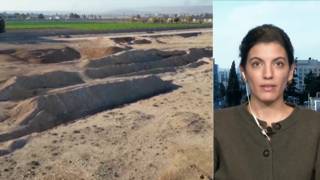
Related
The Census Bureau has altered the nation’s political landscape with its once-a-decade rearranging of congressional districts to reflect changes in the population. Democratic states such as New York and Massachusetts lost seats, while Republican-leaning states, such as Arizona and Texas, gained seats. However, much of the population growth is attributed to Hispanics, who tend to vote Democratic. We speak with Tim Storey, senior fellow at the National Conference of Legislatures. [includes rush transcript]
Transcript
AMY GOODMAN: The Census Bureau has altered the nation’s political landscape with its once-a-decade rearranging of congressional districts to reflect changes in the population. On Tuesday, the Census Bureau reapportioned the congressional seats granted to a number of states based on population changes since 2000. Acting Deputy Commerce Secretary Rebecca Blank helped unveil the census figures in Washington, D.C.
REBECCA BLANK: We’re here today to do something that has only taken place 23 times in the nation’s history. We are complying with Article I, Section 2 of the U.S. Constitution, which mandates the actual enumeration of the population every 10 years. The founding fathers of our nation had a bold and ambitious plan to empower the people over their new government. The plan was to count every person living in the United States and to use that count to determine representation in Congress.
Enshrining this mandate in our Constitution marked a turning point in world history. There had been censuses before, but they had been used mainly to collect taxes or to confiscate property or to conscript residents into military service. That is not what the U.S. Census is about. The genius of our founders was taking a tool of government and making it a tool of political empowerment for citizens over their government. We cannot be a representative government without being able to apportion our House of Representatives in a way that reflects the changing nation of the past two centuries. And that requires us to know who lives where. It requires a population census.
AMY GOODMAN: Republicans are widely expected to benefit from the new political map. The Census Bureau took seats from traditionally Democratic states such as New York and Massachusetts and added them to Republican-leaning states such as Arizona and Texas, which picked up four additional seats. Of the 10 states to lose seats, eight voted for President Obama in the 2008 elections.
The reapportionment towards Republican-leaning states also follows major Republican gains in last month’s midterm elections. Those wins will have a big impact when state lawmakers redraw the district boundaries for the House of Representatives.
One of the most high-profile lawmakers who could be impacted by the redistricting is Democratic Congress member Dennis Kucinich of Ohio. He lost two congressional seats in the census reapportionment — Ohio did. That means Republican lawmakers could carve up Kucinich’s district when it comes time to eliminate those two seats.
Overall, the census found the population has grown 9.7 percent since 2000 to over 308 million residents. It was the slowest rate of growth, population, since 1940.
For more on the census redistricting and what it means for the nation’s political landscape, I’m joined by Tim Storey. He’s a senior fellow at the National Conference of Legislatures. He joins us now from Denver.
Welcome to Democracy Now!, Tim Storey. Talk about the significance, what you think are the most important shifts that you see in the 2010 Census.
TIM STOREY: Amy, thank you for inviting me to be on the show.
There were a number of interesting things that we discovered yesterday when the Census Bureau released its new apportionment numbers, and this is really just a kind of the first taste of the wealth of data that’s going to come out from the 2010 Census. Most of that will start rolling out in February of next year and through March of next year. But what we saw yesterday was — I think there weren’t a lot of surprises, actually. The projections and the estimates that we had before the release of the data gave us a pretty good idea of where the shifts were going to take place.
What we found, what was confirmed yesterday, is that the rate of growth in some of the Southern states, the Sun Belt states and Western states is outpacing at a pretty good clip the rate of growth in the Northeast and the Great Lakes states. In fact, the state of Michigan actually declined in population from the 2000 Census. It was the only state that literally lost population during the decade. So, states like Texas, Florida, Arizona, Nevada, you know, gaining both population — almost every state, as I said, has gained in populations. These states are growing at a faster rate. So that translates into direct political power, political influence in the U.S. House of Representatives. It also translates into electoral college votes, because the electoral college totals for each state are based on the U.S. House seats. So, there weren’t a lot of surprises based on the projections, but it did sort of confirm what we’ve known, is that the population is shifting to the South and the West and that the Great Lakes states, the Northeastern states are losing population.
AMY GOODMAN: As it shifts, though, there is a countervailing story, which is the growth of Latinos in these what are called “red states,” the significant growth in populations in places like, well, for example, Texas and Arizona, Tim Storey.
TIM STOREY: That’s right. That’s right, Amy. We won’t know exactly — we won’t know the exact rate of growth among sort of demographic groups within the census until that data is released next year. But the Census Bureau has released some other survey-type data from the American Community Survey and demographic estimates. And from that data, what you’re saying is true. We know that the Hispanic community in Texas and in Arizona, Nevada, is in many ways fueling the growth rate. They have higher birth rates within that community than other demographic segments, and so their population is growing at a much faster rate.
And it raises some interesting questions about the redistricting that will follow this reapportionment — two different things, reapportionment and redistricting. And redistricting is the detailed realignment of districts to match the population shifts. All the districts have to be essentially even in population. And you have to draw the districts where the people are, where the growth is. So if Texas is growing and that growth is primarily in Hispanic areas — and, of course, you’ve also got the Voting Rights Act, which is a major influence on the redistricting process. So when state legislators in Texas draw these new districts, they’re going to have to put them where the people are. And if that growth has been in Hispanic communities, then that’s where the new seats are going to have to go.
AMY GOODMAN: Hispanics accounting for about half the population gains in Florida, Arizona, Nevada, Texas. In Georgia, African Americans and Hispanics contributing more than half the growth. Tim Storey, would you like to comment?
TIM STOREY: You’re exactly right, Amy. Yeah, you’re exactly right. And traditionally minority communities are growing at a faster rate. And that could ultimately translate into political power both in Congress and also in state legislatures, because districts have to be based on population. The Constitution establishes the principle of one person, one vote. So the districts have to be essentially the same number of people, so that everybody’s voice is equally represented in all legislative bodies, whether it’s the U.S. House of Representatives, the state legislature, city councils, county commissions. Any elected body that’s based on population, those districts now have to be redrawn so that they’re even in population. And if population growth in minority communities has been faster, then that’s going to be reflected in the upcoming redistricting.
AMY GOODMAN: I also have an interesting story with Washington, D.C. Washington, D.C., at this point, is not considered a state, but it is for the purposes of counting in the census, and it’s a district that is actually becoming whiter. Is that right, Tim Storey?
TIM STOREY: Well, again, the demographic data, which will sort of tell us the race and ethnicity within the population, that detailed data won’t come out until next February, March. So, right now we have some estimates based on what’s called the American Community Survey. And yes, my understanding, that the demographics of Washington is changing. But you’re right. Washington does not have a seat in the U.S. House of Representatives.
So, when you look at the overall population of a U.S. — a seat in the U.S. House, a U.S. representative, a member of Congress in the U.S. House, will represent about 710,000 people after this apportionment, so — on average. That varies greatly from state to state. In fact, in Montana, Montana isn’t quite big enough to get a second seat in Congress. They only get one seat in Congress. And the population of Montana is just under a million people. So, the House member from Montana will actually represent a million people, and the House member from Wyoming will represent only about half a million people. So, the population can vary somewhat, but the District of Columbia actually has — does not have a member of the U.S. Congress that has voting rights on the floor. Of course, they have a delegate that’s a member of committees and active in other ways in the House.
AMY GOODMAN: There’s an interesting piece in the Washington Post saying, “Reversing a half-century of decline, the District’s population grew more than 5 percent […] and sailed past 600,000 residents.” And it says that the “growth has swelled the number of residents in every quadrant of the city and shifted the District’s racial and ethnic mix. Whites and Hispanics have been moving in, while many African Americans have left and might be a minority before the next census is taken.”
But let’s shift now to Ohio. Dennis Kucinich, extremely outspoken Congress member — Cleveland is getting smaller. And talk about the significance of this for redistricting, Tim Storey.
TIM STOREY: Well, Ohio is a state where the state legislature has the responsibility for drawing the new districts. Ohio, as a state, has been growing at a much slower rate than other states like Texas and Florida and Arizona and Nevada. So, Ohio is one of two states that’s losing more than one seat in Congress, New York being the other one. And so, Ohio is losing two seats. And that means that because the legislature is now controlled by Republicans — as you mentioned at the beginning of the segment, the GOP had an extremely successful election at the state level in 2010. In fact, there are now more Republican state legislators than at any point since 1928. And this is on the heels of what had been some very strong Democratic successes in state legislatures. But 2010 was a pretty bad year for Democrats at the state legislative level, including in Ohio. So now Republican legislators and a new Republican governor in Ohio, John Kasich, will be ultimately responsible for drawing the new district lines for Congress in Ohio. So Democrats in Ohio, especially in places where the population is on the decline, like in Cleveland, are probably going to be sort of fighting for their political lives in the redistricting process.
AMY GOODMAN: Tim Storey, can you talk about how the Voting Rights Act affected redistricting and, in particular, where the states will — the Voting Rights Act will bear on how communities are restricted?
TIM STOREY: Yes, Amy. The Voting Rights Act has a tremendous influence on how districts are drawn. Of course, it doesn’t really affect the reapportionment, just the release of these numbers. But when the redistricting process begins in February and March, as I said, when that detailed data comes out that tells us the demographics of the country, the Voting Rights Act will have an extraordinarily important effect on how the districts are drawn. Of course, the Voting Rights Act was renewed since last census, since the last redistricting cycle, and continues to be a major part, one of the top-level criteria that — whether it’s state legislators — there are a handful of states that have a commission that draws new districts. So, whoever is drawing those lines, they have to be especially aware of where minority populations are concentrated.
In fact, what the act says is that if a minority group lives in a geographically compact area, they tend to vote as a group. And if white voters — the preference of white voters has traditionally defeated the candidate of choice for the minority community, then whoever draws those lines has to draw districts that gives them the opportunity to elect the candidate of their choice. This has resulted in a number of majority minority districts throughout the country, many of them in the South. And many of the members of Congressional Black Caucus, the Congressional Hispanic Caucus come from these districts. So the Voting Rights Act has a tremendous influence on the redistricting process.
AMY GOODMAN: And who draws those lines, Tim Storey?
TIM STOREY: You know, the redistricting process and who actually conducts the plan development, the line drawing, varies from state to state. At the congressional level, the U.S. House district lines, there are seven states that have a board or a commission that draws the lines. The makeup of those commissions varies within those seven states. Some of them are probably more independent than others. But some of them are very partisan, some of those commissions.
In the other 43 states, the legislature has the primary responsibility and authority to draw the new district lines. Now, one state, Iowa, has a very unique process, where they draw districts without any election data, any political data. But then the legislature votes on those plans. So Iowa is sort of in a category all its own. So you take them out, and in 42 states it’s the legislature, with the governor’s approval in most cases. North Carolina and Connecticut are exceptions to that rule, where the legislature, without governor approval, will draw the lines for the U.S. House. But in most cases, it’s the legislature that has the responsibility to draw the new districts, before the next election. Under the Constitution, we can’t hold new elections in these population-based districts — U.S. House, state legislature — until we redraw the lines. So, all the new districts will essentially be unconstitutional when this data comes out early next year.
AMY GOODMAN: Well, Tim Storey, I want to thank you very much for being with us, senior fellow at the National Conference of Legislatures, joining us from Denver, from our friends at Rocky Mountain PBS.












Media Options